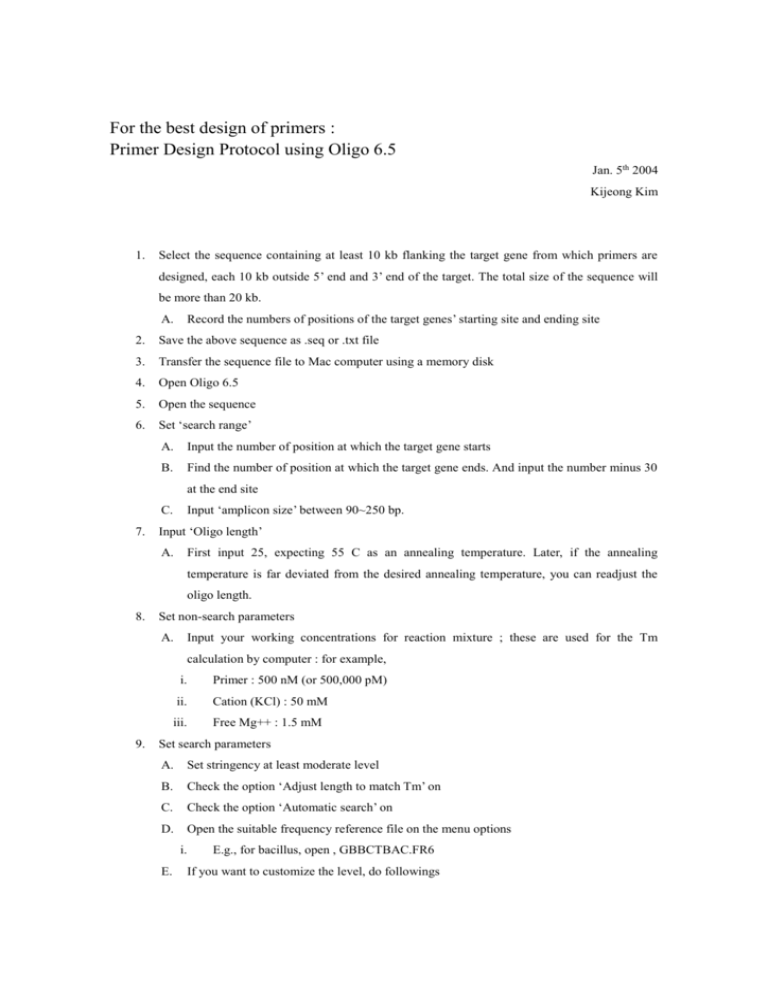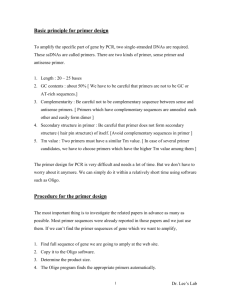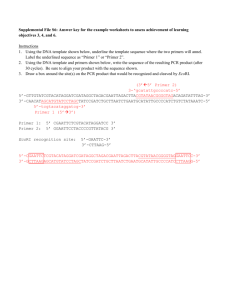Primer Design Protocol using Oligo 6.5
advertisement

For the best design of primers : Primer Design Protocol using Oligo 6.5 Jan. 5th 2004 Kijeong Kim 1. Select the sequence containing at least 10 kb flanking the target gene from which primers are designed, each 10 kb outside 5’ end and 3’ end of the target. The total size of the sequence will be more than 20 kb. A. Record the numbers of positions of the target genes’ starting site and ending site 2. Save the above sequence as .seq or .txt file 3. Transfer the sequence file to Mac computer using a memory disk 4. Open Oligo 6.5 5. Open the sequence 6. Set ‘search range’ A. Input the number of position at which the target gene starts B. Find the number of position at which the target gene ends. And input the number minus 30 at the end site Input ‘amplicon size’ between 90~250 bp. C. 7. Input ‘Oligo length’ A. First input 25, expecting 55 C as an annealing temperature. Later, if the annealing temperature is far deviated from the desired annealing temperature, you can readjust the oligo length. 8. Set non-search parameters A. Input your working concentrations for reaction mixture ; these are used for the Tm calculation by computer : for example, 9. i. Primer : 500 nM (or 500,000 pM) ii. Cation (KCl) : 50 mM iii. Free Mg++ : 1.5 mM Set search parameters A. Set stringency at least moderate level B. Check the option ‘Adjust length to match Tm’ on C. Check the option ‘Automatic search’ on D. Open the suitable frequency reference file on the menu options i. E. E.g., for bacillus, open , GBBCTBAC.FR6 If you want to customize the level, do followings i. Set maximal length of dimers [4] bp ii. Set 3’ terminal NT check for dimers [the oligo length – 2], e.g., 23 iii. Set 3’ terminal stability [-5.5 ] ~ [-8.5 ] kcal/mol iv. Set GC clamp stability less than –10 kcal/mol v. Open frequency table : for Bacillus, GBBCTBAC.FR6 vi. Set frequency threshold less than 1150 vii. Set allowable length of homo-oligos [4] viii. Set false priming points : [170] ix. Set minimal consensus priming points : [340] x. If you have other sequence files for mispriming search, you can designate the file 10. Run primer searching A. Automatic search by computer is very enough to use the primers suggested. B. If there are no suggested primer pairs, reduce the stringency level and retry the run. 11. Suitable primer pairs will appear on the table 12. Select the most suitable primer pair among them A. First choose primer pairs meeting the desired optimal annealing temperature i. Here, if there are no primer pairs of the annealing temperature, you can adjust the oligo length and rerun the primer searching. 1. If the optimal annealing temperatures of the suggested primers are too low than the desired, increase the length of oligo size. Vice versa. B. note the primer internal stability : 3’ pentamer flexibility for specificity i. Toward 5’ end, the less delta G, the more stable binding ii. Toward 3’ end ,the higher delta G, the better specificity (should higher than –8.5 kcal/mol) C. Note the duplex and hair pin structure formation i. BASIC importances : 1. Dimer formation at the 3’ end is the worst 2. If there is no significant dimer formation at the 3’ end, any other dimer formation with even less energy than –10 kcal/mol is not so much of problem, because polymerization on the dimer won’t easily occur, though dimer is formed. 3. Ideally, the less overall dimer formation between self-primers or non-selfprimers is there, the better PCR works. ii. The higher energy, the better; the higher will form less duplexes. 1. e.g., -3.5 kcal/mol is better than –5.0 kcal/mol 2. I like the higher than –5.0 kcal/mol 3. Avoid the primers if the duplex energy is less than –10 kcal/mol iii. Particularly, avoid the duplex formation and the low energy at 3’ end 1. iv. I suggest >-3.0 kcal/mol If there is a hair pin formation, it will be shown. 1. If you used the parameter at higher than moderate level, there is no problem, even though the hair pin formation is suggested, for the melting temperature of hair pin is much less than annealing tempearautre. v. Check all possible primer duplexs 1. Upper primer duplex formation 2. Lower primer duplex formation 3. Upper/Lower primer duplex formation 13. Now it’s ready; See the suggested PCR information A. There will be i. suggested optimal temperature ii. Amplicon size iii. Tm’s of amplicon and primers iv. Tm differences between primers, and primers and product







